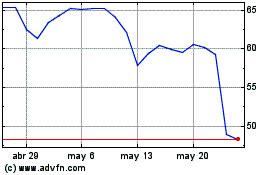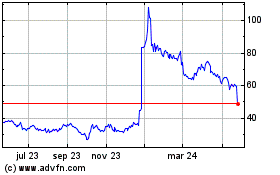Cytokinetics, Incorporated (Nasdaq: CYTK) today announced that
additional data from SEQUOIA-HCM (
Safety,
Efficacy, and
Quantitative
Understanding of
Obstruction
Impact of
Aficamten in
HCM), the pivotal Phase 3 clinical trial of
aficamten in patients with symptomatic obstructive hypertrophic
cardiomyopathy (HCM), were presented at the Hypertrophic
Cardiomyopathy Medical Society (HCMS) Scientific Sessions by Anjali
T. Owens, M.D., Medical Director of the Center for Inherited
Cardiac Disease and Assistant Professor of Medicine at the
University of Pennsylvania.
A new analysis from SEQUOIA-HCM showed that
treatment with aficamten was associated with beneficial changes in
five indices reflecting structural, electrophysiologic and
biomarker changes in patients from SEQUOIA-HCM. This analysis was
performed in patients treated with aficamten and compared to
placebo, at 24 weeks as follows:
- Improvement in maximal wall
thickness by ≥1.5 mm (n = 282; 47.9% vs 30.7%; p=0.003)
- Improvement in left atrial volume
index (LAVI) category in those with mild, moderate, or severe
enlargement at baseline (n = 185; 46.8% vs. 18.7%; p<0.001)
- Resolution of ECG changes
consistent with left ventricular hypertrophy (n = 282; 19.0% vs.
4.3%; p<0.001)
- Normalization of hyperdynamic left
ventricular ejection fraction (defined as ≥72%) into the normal
range (n = 282; 35.2% vs 20.7%; p<0.007)
- Reduction in NT-proBNP by ≥50% from
baseline (n = 282; 81.7% vs. 7.1%; p<0.001).
Overall, 83.8% of patients treated with
aficamten experienced favorable effects in at least one of the five
domains, compared to 39.3% of patients on placebo (p<0.001, NNT
= 2.2).
“This new analysis evaluated clinical data from
SEQUOIA-HCM through the lens of remodeling to characterize the
impact of treatment with aficamten in patients with obstructive HCM
in terms of structural and functional changes. The results
demonstrated favorable remodeling across multiple domains,
including cardiac structure and function, electrophysiology and
biochemistry,” said Stephen Heitner, M.D., Vice President, Head of
Clinical Research. “We are encouraged by these findings, and we
look forward to further expanding our understanding of the
long-term clinical outcomes of treatment with aficamten through our
continued conduct of FOREST-HCM, the open-label extension clinical
study.”
Poster Abstract Presentation
Update
Due to Hurricane Helene and its expected impact
to the Atlanta, GA area, the HCMS Scientific Sessions have
converted from in person to virtual presentations. As such, the
Company has decided to withdraw the poster entitled “Efficacy and
Safety of Aficamten in Patients with Obstructive Hypertrophic
Cardiomyopathy and Very High Left Ventricular Outflow Tract
Gradients” from the sessions. The Company plans to submit the
poster for presentation at a future medical meeting where it can be
presented in person.
About
Aficamten
Aficamten is an investigational selective, small
molecule cardiac myosin inhibitor discovered following an extensive
chemical optimization program that was conducted with careful
attention to therapeutic index and pharmacokinetic properties and
as may translate into next-in-class potential in clinical
development. Aficamten was designed to reduce the number of active
actin-myosin cross bridges during each cardiac cycle and
consequently suppress the myocardial hypercontractility that is
associated with hypertrophic cardiomyopathy (HCM). In preclinical
models, aficamten reduced myocardial contractility by binding
directly to cardiac myosin at a distinct and selective allosteric
binding site, thereby preventing myosin from entering a force
producing state.
The development program for aficamten is
assessing its potential as a treatment that improves exercise
capacity and relieves symptoms in patients with HCM as well as its
potential long-term effects on cardiac structure and function.
Aficamten was evaluated in SEQUOIA-HCM (Safety,
Efficacy, and Quantitative
Understanding of Obstruction
Impact of Aficamten in
HCM), a positive pivotal Phase 3 clinical trial in
patients with symptomatic obstructive hypertrophic cardiomyopathy
(HCM). Aficamten received Breakthrough Therapy Designation for the
treatment of symptomatic obstructive HCM from the U.S. Food &
Drug Administration (FDA) as well as the National Medical Products
Administration (NMPA) in China.
Aficamten is also currently being evaluated
in MAPLE-HCM, a Phase 3 clinical trial of aficamten as
monotherapy compared to metoprolol as monotherapy in patients with
obstructive HCM, ACACIA-HCM, a Phase 3 clinical trial
of aficamten in patients with non-obstructive HCM, and
CEDAR-HCM, a clinical trial of aficamten in a pediatric
population with obstructive HCM, and FOREST-HCM, an open-label
extension clinical study of aficamten in patients with
HCM.
About Hypertrophic
Cardiomyopathy
Hypertrophic cardiomyopathy (HCM) is a disease
in which the heart muscle (myocardium) becomes abnormally thick
(hypertrophied). The thickening of cardiac muscle leads to the
inside of the left ventricle becoming smaller and stiffer, and thus
the ventricle becomes less able to relax and fill with blood. This
ultimately limits the heart’s pumping function, resulting in
reduced exercise capacity and symptoms including chest pain,
dizziness, shortness of breath, or fainting during physical
activity. HCM is the most common monogenic inherited cardiovascular
disorder, with approximately 280,000 patients diagnosed, however,
there are an estimated 400,000-800,000 additional patients who
remain undiagnosed in the U.S.1,2,3 Two-thirds of patients with HCM
have obstructive HCM (oHCM), where the thickening of the cardiac
muscle leads to left ventricular outflow tract (LVOT) obstruction,
while one-third have non-obstructive HCM (nHCM), where blood flow
isn’t impacted, but the heart muscle is still thickened. People
with HCM are at high risk of also developing cardiovascular
complications including atrial fibrillation, stroke and mitral
valve disease.4 People with HCM are at risk for potentially fatal
ventricular arrhythmias and it is one of the leading causes of
sudden cardiac death in younger people or athletes.5 A subset of
patients with HCM are at high risk of progressive disease leading
to dilated cardiomyopathy and heart failure necessitating cardiac
transplantation.
About Cytokinetics
Cytokinetics is a late-stage, specialty
cardiovascular biopharmaceutical company focused on discovering,
developing and commercializing muscle biology-directed drug
candidates as potential treatments for debilitating diseases in
which cardiac muscle performance is compromised. As a leader in
muscle biology and the mechanics of muscle performance, the company
is developing small molecule drug candidates specifically
engineered to impact myocardial muscle function and contractility.
Cytokinetics is preparing for regulatory submissions for aficamten,
its next-in-class cardiac myosin inhibitor, following positive
results from SEQUOIA-HCM, the pivotal Phase 3 clinical trial in
obstructive hypertrophic cardiomyopathy which were published in the
New England Journal of Medicine. Aficamten is also currently being
evaluated in MAPLE-HCM, a Phase 3 clinical trial of aficamten as
monotherapy compared to metoprolol as monotherapy in patients with
obstructive HCM, ACACIA-HCM, a Phase 3 clinical trial of aficamten
in patients with non-obstructive HCM, CEDAR-HCM, a clinical trial
of aficamten in a pediatric population with obstructive HCM, and
FOREST-HCM, an open-label extension clinical study of aficamten in
patients with HCM. Cytokinetics is also developing omecamtiv
mecarbil, a cardiac muscle activator, in patients with heart
failure. Additionally, Cytokinetics is developing CK-586, a cardiac
myosin inhibitor with a mechanism of action distinct from aficamten
for the potential treatment of HFpEF.
For additional information about Cytokinetics,
visit www.cytokinetics.com and follow us on X, LinkedIn, Facebook
and YouTube.
Forward-Looking Statements
This press release contains forward-looking
statements for purposes of the Private Securities Litigation Reform
Act of 1995 (the “Act”). Cytokinetics disclaims any
intent or obligation to update these forward-looking statements and
claims the protection of the Act’s Safe Harbor for forward-looking
statements. Examples of such statements include, but are not
limited to, statements express or implied relating to the
properties or potential benefits of aficamten or any of our other
drug candidates, our ability to obtain regulatory approval for
aficamten for the treatment of obstructive hypertrophic
cardiomyopathy or any other indication from FDA or any other
regulatory body in the United States or abroad, and the labeling or
post-marketing conditions that FDA or another regulatory body may
require in connection with the approval of aficamten. Such
statements are based on management’s current expectations, but
actual results may differ materially due to various risks and
uncertainties, including, but not limited to the risks related to
Cytokinetics’ business outlines in Cytokinetics’ filings with
the Securities and Exchange Commission. Forward-looking
statements are not guarantees of future performance, and
Cytokinetics’ actual results of operations, financial condition and
liquidity, and the development of the industry in which it
operates, may differ materially from the forward-looking statements
contained in this press release. Any forward-looking statements
that Cytokinetics makes in this press release speak only
as of the date of this press
release. Cytokinetics assumes no obligation to update its
forward-looking statements whether as a result of new information,
future events or otherwise, after the date of this press
release.
CYTOKINETICS® and the C-shaped logo are
registered trademarks of Cytokinetics in the U.S. and certain other
countries.
Contact:Cytokinetics Diane WeiserSenior Vice
President, Corporate Affairs(415) 290-7757
References:
- CVrg: Heart Failure 2020-2029, p 44; Maron et al. 2013 DOI:
10.1016/S0140-6736(12)60397-3; Maron et al 2018
10.1056/NEJMra1710575
- Symphony Health 2016-2021 Patient Claims Data DoF;
- Maron MS, Hellawell JL, Lucove JC, Farzaneh-Far R, Olivotto I.
Occurrence of Clinically Diagnosed Hypertrophic Cardiomyopathy in
the United States. Am J Cardiol. 2016; 15;117(10):1651-1654.
- Gersh, B.J., Maron, B.J., Bonow, R.O., Dearani, J.A., Fifer,
M.A., Link, M.S., et al. 2011 ACCF/AHA guidelines for the diagnosis
and treatment of hypertrophic cardiomyopathy. A report of the
American College of Cardiology Foundation/American Heart
Association Task Force on practice guidelines. Journal of the
American College of Cardiology and Circulation, 58, e212-260.
- Hong Y, Su WW, Li X. Risk factors of sudden cardiac death in
hypertrophic cardiomyopathy. Current Opinion in Cardiology. 2022
Jan 1;37(1):15-21
Cytokinetics (NASDAQ:CYTK)
Gráfica de Acción Histórica
De Dic 2024 a Ene 2025

Cytokinetics (NASDAQ:CYTK)
Gráfica de Acción Histórica
De Ene 2024 a Ene 2025
